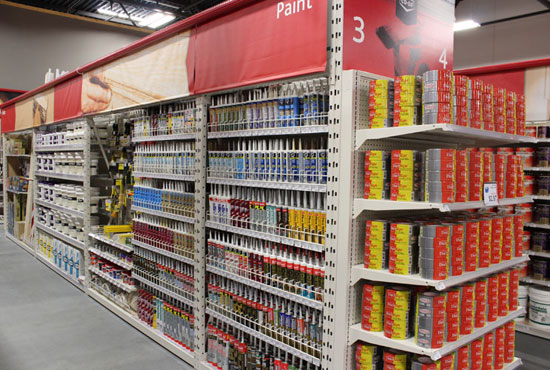The Power of Overhead Storage
Back in the day, every building centre had a back stockroom – and many had several. There just wasn’t room on the sales floor for the growing variety of products being developed for the DIY market. There were stores that had a complete replica of the showroom above the store on a mezzanine or underneath the store in the basement. Whatever didn’t fit on the shelf went to back stock.
There were many problems with this system:
- There were lots of out-of-stocks in the showroom because staff didn’t have the time or inclination to dig product out of back stock.
- Service was negatively affected because sales staff was constantly off the floor looking for product in back stock while customers waited.
- Inventory got out-of-whack because purchasers didn’t take the time to check back stock and acted on information from sales staff that product was out-of-stock.
- Inventory was difficult to control because of multiple locations for the same product. Year-end counts were difficult and time consuming.
- Merchandising sets could never be maintained because it was easier to add a peg or shelf position to accommodate incoming product than to run the extra items down to the basement. The constant shuffling of products meant SKU’s disappeared without anyone noticing.
A New Way to Store Overstock
The box stores had a better idea. They put all the stock onto the sales floor. They used the “free” real estate above the 8′ level to store all their overstock. This allowed them to buy more efficiently, reduce handling costs, keep the shelves full, and perfect and maintain their merchandising sets to maximize sales.
The early versions of the box store featured 16’ racking throughout the sales floor. Sales levels at these first stores (think Aikenhead’s) justified the massive amounts of inventory needed to fill these racks. As their numbers swelled, these stores started to cannibalize each other and inventory levels had to drop to maintain turns. New stores were built with 12’ racking.
When we started working with independent dealers to design their stores, the most common refrain was “we don’t want to look like a box store”. At the same time, they could understand the operational benefits of overhead storage. The first few stores we renovated went with 10’ high racks. We merchandised to 8’ and then had two feet of storage. While the system worked reasonably well, the top foot of merchandising was unnecessary because customers couldn’t reach it. Accessing the overstock required rolling ladders which were cumbersome in stores with 4’ aisles.
We reduced the racking to 7’ plus 2’ of overhead storage on interior runs and this worked beautifully. It’s a comfortable height for customers and it’s easy for staff to access the overstock. Some stores were able to convert back stock rooms to sales floor by removing walls. Others tore out mezzanines creating an open feel that made the store feel much larger.
The Survey Says…..
Surveys consistently tell us the number one reason for customers selecting your store is that you have what they need. Effectively using overhead storage is the simplest way to improve your customers’ perception and experience against this most important attribute.
Stores that have adopted the system love it. Renovated stores look great months and years after they are complete. Everything is in its place, no boxes on the floor and shelves are full. Dealers report higher staff morale, positive customer feedback, higher sales and higher margins. Who’d have thought such a simple concept could have so much power?
Burlington Merchandising & Fixtures provides innovative merchandising solutions to both retailers and vendors with a focus on driving sales and profitability. Contact us today to get started!
You might also like:


